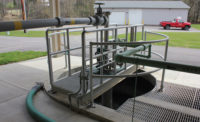You’ll stare at it, but you won’t see it. You’ll consume it, but you won’t taste it. It is an invisible problem lurking within pipes and affecting cities across the nation.
This may sound like a trailer for a thriller movie, but in reality it’s the serious water crisis currently confronting America. A recent study by the American Water Works Association (“National Survey of Lead Service Line Occurrence”) estimates there are about 6.1 million lead service lines in the ground across 11,200 community water systems in the United States.
However, the lack of real lead service line inventories by many public water systems could mean this estimate is conservative. As local officials, building owners and taxpayers grapple with how to deal with the risk posed to drinking water, they are making decisions on piping replacement that can have effects long into the future.
Lead and drinking water don’t mix
Lead itself is not inherently bad. It is a vital component of the lead-acid battery – a technology that powers our lives every day. In fact, lead once was prized for its longevity and formability — at one time making it the preferred piping material. By 1900, more than 70% of cities in the U.S. with populations greater than 30,000 were using lead water lines. However, warning signs began popping up as the health impacts of the ingestion of lead started to become known.
When ingested, lead is a serious neurotoxin with severe adverse health effects associated with even very low intake concentrations. In fact, according to the Environmental Protection Agency, no amount of lead ingestion as indicated by blood lead levels is safe for children. Lead intake can cause developmental delays, irreversible cognitive and behavioral problems, anemia, seizures, coma and other adverse health issues.
To address the problem and reduce the risk of lead exposure through drinking water, the EPA instituted stringent requirements on the amount of lead that can be present in drinking water before actions must be taken. While there are many compounds controlled by the Safe Drinking Water Act, the levels at which they are controlled show their relative potential impact on health. Lead is regulated at 15 parts per billion in water, 87 times more restrictive than the 1,300 ppb allowable for copper.
In some ways, this is all old news. Copper and other materials have long since replaced lead in new construction – so this problem is one of remediating the past since many cities have yet to replace old lead service lines. However, Flint, Mich., among many other municipalities, has brought to the forefront the inherent risk in not addressing the large volume of lead service lines buried within the aging water infrastructure of the country — a risk that with one change of the water supply or water treatment can expose citizens to unsafe levels of lead in their drinking water. In Flint, corrosive waters from the Flint River combined with a lack of corrosion control treatment caused aging lead pipes to leach into the water supply, resulting in toxic levels of lead in drinking water. Between six and 12,000 children may have been exposed.
Now, homeowners and city officials from around the U.S. have suddenly become hyperaware of the quality of their drinking water and the importance of their water infrastructure. A 2016 review of the EPA enforcement data by USA Today reveals nearly 2,000 drinking water systems serving six million people in all 50 states have experienced excessive or harmful levels of lead, with 373 of these systems repeatedly failing for excessive lead. Perhaps the best way to eliminate the risk now and for all future generations is to remove and replace all lead service lines from our critical water infrastructure.
We are entering what many are referring to as the “Replacement Era,” a time where much of our nation’s drinking water infrastructure needs to be replaced. The decisions city officials and homeowners make and the materials they select will have consequences long into the future.
They could choose the “short-term money-saving option” that has the potential to leach small amounts of contaminants that do not offer any health benefits or for which their health impacts are not fully known and are being considered, or they could choose to make an investment by selecting what 80% of all utilities choose for service lines — copper.
Historical option
Copper tube and fittings have a long history of being durable, reliable and safe — actually, copper is a dietary micronutrient, necessary for human health. Plus, copper piping systems are lead-free. The copper tube and fittings themselves always have been lead-free. In addition, solders and fluxes have been lead-free since 1978.
Lead in brass components for plumbing has been steadily reduced, with today’s new components mandated to contain less than 0.25% lead content (weighted average) of surfaces exposed to water. All copper-alloy plumbing components have needed to pass the NSF 61 criteria for drinking water safety for many years.
Copper pipe and tube long has been preferred for drinking water lines because of its corrosion resistance, formability, join-ability, dependability, recyclability and safety. It is completely impermeable, unlike other materials that can be used for service lines, so it keeps outside chemicals from contaminating the water system.
Chemicals such as petroleum products that may be spilled on nearby streets, as well as insecticides and fertilizers that are intentionally spread on yards — places where service lines are located — can permeate through the walls of plastic service lines, weakening the lines and contaminating the water within. In underground applications where freezing and thawing and other natural occurrences cause the ground to settle and move, copper can withstand these stresses without failure, while other materials crack, rupture and leak.
Copper is a safe plumbing material and no other material has been found to be superior for conveying water. In fact, the history of copper in delivering water goes back more than 4,000 years. Copper was used as a conduit material to distribute water at Abusir by the ancient Egyptians around 2150 B.C. It was widely used as water pipes and cisterns by the ancient Romans.
By the 1940s, copper became the most used material for plumbing in the developed world. A properly designed and installed copper water tube assembly can last the entire life of a building, and once the building reaches the end of its life, the copper can be readily reclaimed and recycled back to its original purity as piping, wiring or any other copper product. Its long life cycle, combined with its ease of recyclability back to the same metal purity (not downcycled to a lower purity or lesser use), makes copper a truly sustainable piping material.
Getting in gear
This explains the actions taken by the city of Madison, Wis., 15 years ago to initiate its own replacement programs using copper. The state capital replaced more than 8,000 of its lead lines with copper from 2001-2011 after discovering lead levels over the federal limit. Instead of making minor changes and pushing a potential problem to future generations, city officials took action despite public pushback.
Service line replacements can be a big undertaking considering a recent study in the journal Environmental Engineering Science recommended lead service lines should be replaced in their entirety. Creating a “hybrid” system by replacing sections with alternate materials can exacerbate lead leaching, at least in the short-term, into drinking water tubes. Municipalities considering updating their service line systems should replace them entirely with copper in order to help protect the integrity and safety of the water they are supplying.
Officials in Flint are not taking any chances; they already have started replacing all the city’s lead pipes with copper — a project that will cost an estimated $55 million. The city of Milwaukee also has started to remove all lead pipes or laterals and replace them with copper, a project that will cost an estimated half-billion dollars. In other cities such as Chicago, residents are demanding government officials look into replacing all lead pipes.
In addition, Canadian cities such as Toronto, Montreal, Ottawa, London and Winnipeg, to name a few, have been steadily working on replacing lead service lines with copper. Montreal announced in 2007 the start of a multiyear program to replace about 75,000 lead services supplying water to residences of less than eight units built before 1970. Toronto is in the midst of a program to replace about 140,000 lead or galvanized-steel services. The common factor for many of these programs is a consistent, deliberate choice to replace with copper for long-term reliability of this hard-to-reach, hard-to-replace infrastructure — favoring lifecycle value over short-term cost.
Flint certainly has captured the attention of the nation and the global water industry. The situation in that Michigan city is, indeed, a tragedy. But more than that, it represents an opportunity to rise above such misfortune to address serious water infrastructure issues and prevent future disasters.
It also highlights the long-term importance in the material selection process — we are replacing service lines today that have been in service for perhaps 75-100 years. Copper has proven it can provide decades of reliable performance in this critical service line infrastructure.
This article was originally titled “A lurking problem” in the September 2016 print edition of PM Engineer.




